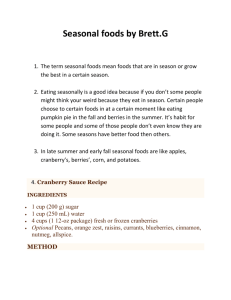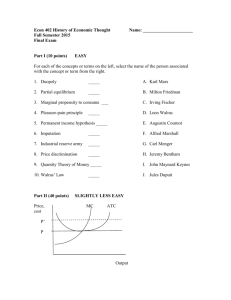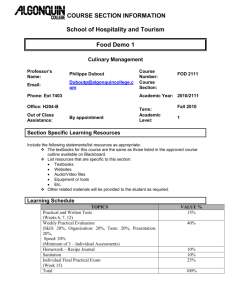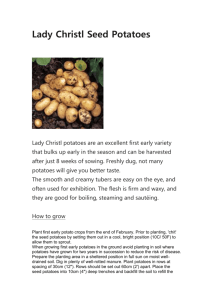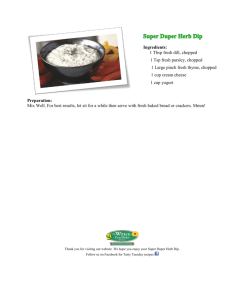WEEK 5-SEGMENTATION, TARGETING AND
advertisement
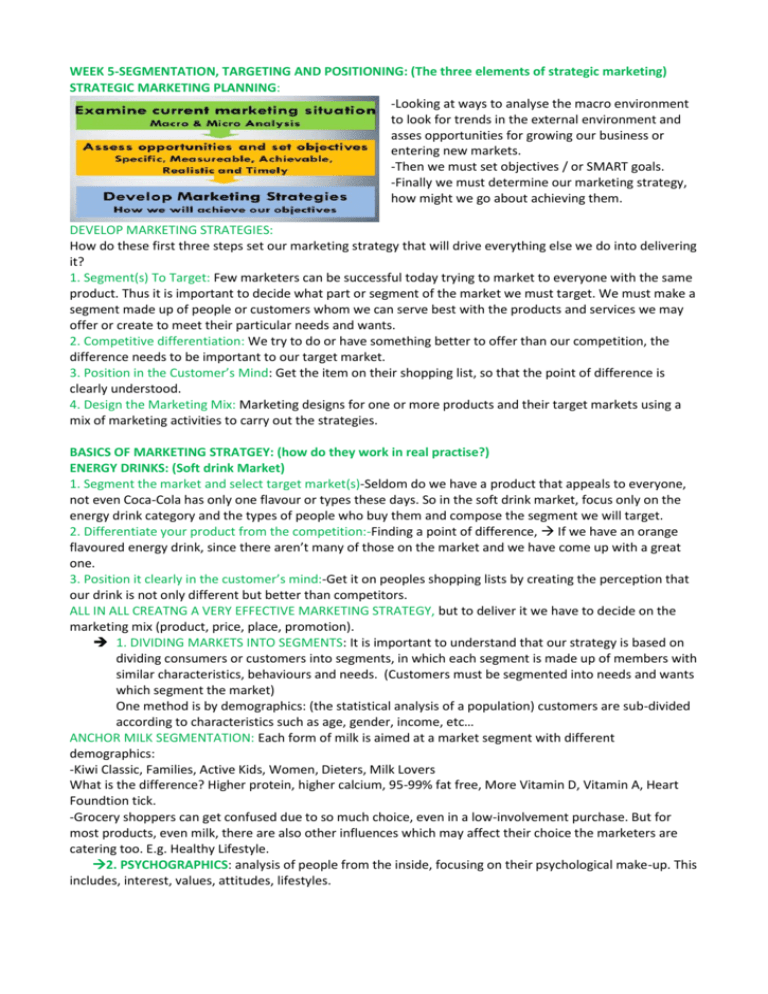
WEEK 5-SEGMENTATION, TARGETING AND POSITIONING: (The three elements of strategic marketing)
STRATEGIC MARKETING PLANNING:
-Looking at ways to analyse the macro environment
to look for trends in the external environment and
asses opportunities for growing our business or
entering new markets.
-Then we must set objectives / or SMART goals.
-Finally we must determine our marketing strategy,
how might we go about achieving them.
DEVELOP MARKETING STRATEGIES:
How do these first three steps set our marketing strategy that will drive everything else we do into delivering
it?
1. Segment(s) To Target: Few marketers can be successful today trying to market to everyone with the same
product. Thus it is important to decide what part or segment of the market we must target. We must make a
segment made up of people or customers whom we can serve best with the products and services we may
offer or create to meet their particular needs and wants.
2. Competitive differentiation: We try to do or have something better to offer than our competition, the
difference needs to be important to our target market.
3. Position in the Customer’s Mind: Get the item on their shopping list, so that the point of difference is
clearly understood.
4. Design the Marketing Mix: Marketing designs for one or more products and their target markets using a
mix of marketing activities to carry out the strategies.
BASICS OF MARKETING STRATGEY: (how do they work in real practise?)
ENERGY DRINKS: (Soft drink Market)
1. Segment the market and select target market(s)-Seldom do we have a product that appeals to everyone,
not even Coca-Cola has only one flavour or types these days. So in the soft drink market, focus only on the
energy drink category and the types of people who buy them and compose the segment we will target.
2. Differentiate your product from the competition:-Finding a point of difference, If we have an orange
flavoured energy drink, since there aren’t many of those on the market and we have come up with a great
one.
3. Position it clearly in the customer’s mind:-Get it on peoples shopping lists by creating the perception that
our drink is not only different but better than competitors.
ALL IN ALL CREATNG A VERY EFFECTIVE MARKETING STRATEGY, but to deliver it we have to decide on the
marketing mix (product, price, place, promotion).
1. DIVIDING MARKETS INTO SEGMENTS: It is important to understand that our strategy is based on
dividing consumers or customers into segments, in which each segment is made up of members with
similar characteristics, behaviours and needs. (Customers must be segmented into needs and wants
which segment the market)
One method is by demographics: (the statistical analysis of a population) customers are sub-divided
according to characteristics such as age, gender, income, etc…
ANCHOR MILK SEGMENTATION: Each form of milk is aimed at a market segment with different
demographics:
-Kiwi Classic, Families, Active Kids, Women, Dieters, Milk Lovers
What is the difference? Higher protein, higher calcium, 95-99% fat free, More Vitamin D, Vitamin A, Heart
Foundtion tick.
-Grocery shoppers can get confused due to so much choice, even in a low-involvement purchase. But for
most products, even milk, there are also other influences which may affect their choice the marketers are
catering too. E.g. Healthy Lifestyle.
2. PSYCHOGRAPHICS: analysis of people from the inside, focusing on their psychological make-up. This
includes, interest, values, attitudes, lifestyles.
Customer segments can differ by wants and needs during the day; e.g in McDonalds (eating habits at a
particular time of the day), in the morning’s people desire sausages and pancakes, meanwhile in the
afternoon people desire chicken wrap. This helps to develop McDonald’s menu so they can operate 24/7.
-Porsche demographics: Middle-aged men with high incomes brackets living in large cities etc…
Psychographics: the bigger the price tag the bigger the purchase involvement. Predominant buyers will be
high achievers, status seekers, extension of personality, etc…
This helps us develop better marketing communications such as advertising for this target market.
Often business’ describe market segments by names that people can relate too.
E.g. Air New Zealand customer segment Psychographics:
-SOCIALITIES: 29% Bart Simpson, look for airline to stimulate them
-TERRITORIALISTS: 26% Mr Burns, close relationship to space
-JADED FLYERS: 18% Mo the bartender, hard to please, been there done that
-COCOONERSL 17% Lisa Simpson, get there, entertain themselves
-POSITIVIST: 10% Marge Simpson, love to travel, engage with everything
When differences in buying behaviour are influenced by where people live: GEOGRAPHIC SEGMENTATION:
segmenting the market into different geographic units such as cities, regions or even other countries. Allows
companies to customise and sell products that meet the needs of people based on where they live.
Tourism New Zealand’s marketing is designed to attract travellers from different countries. The New Zealand
“100% Pure You” campaign targets different countries that has been successful for well over 10 years no was
being modified slightly to put the emphasis on the people themselves enjoying activities in New Zealand
100% Pure YOU: different advertisements have been produced for each of the different companies in the
campaign. How New Zealand is sold to the world is now on a PERSONAL LEVEL (previously tourism NZ relied
on the beauty of NZ to bring in tourists, now they are personalising the experience).
2. DIFFERENTIATION: Finding a point of difference (Do I have a sustainable competitive advantage?)
-Can we identify or create a difference or differenced that are important to our customer and will set us
apart from our competitors? Finding a sustainable point of difference that customers will not be able to
copy is extremely difficult. More and more good marketers are focusing just on great service, something that
is not easy to copy OR do better.
-DIFFERENTIATION STRATEGIES: Important points of difference (these need to be important to the
customer)
-Added value benefits customers (so we are selected over competitors)
-Low cost or other differentiation:
-Lighter, faster, easier to use, better service, lasts longer, more choice etc…
SUBWAY continues to add value for customers and competitive advantage: e.g Healthier options, more
menu options, school lunch programmes, reward programme (Subcard) etc… (One of the fastest growing
franchisers in the world)
3. POSITIONING BASICS: Finding or creating a point of difference is seldom enough, we must communicate it
effectively by consistently telling why the product is better by some important attribute. Making our story o
memorable that it will be remembered and added to the customers shopping list; great marketers do this by
utilising their logo and slogan and having consistent brand communication.
REPOSITIONING: sometimes we have to rethink our business strategy which may change the value
proposition, our points of difference, call for a new image, a new look, everything we do to communicate the
new perception we want customers to have of us. e.g. How Air New Zealand changes its image after a failed
merger in 2000:
(totally repositioned itself over a period of 10 years )-Became perceived as a smart company from a unique
country
-Was prepared to lead industry innovation, became service and performance driven, was able to have a bit
of uniquely kiwi fun. Result: World’s Best Airline Award 2010&2012
It’s promotional budget is quite small compared to other airlines, strategic use of social media (youtube)
with humour and uniqueness has entertained and created a perception of an airline that would be fun to fly
with. youtube costed less and reached an equivalent amount of customers as television would have.
POSITIONING IS ABOUT CREATING THE DESIRED BRAND PERCEPTION: Positioning is the battle of the mind,
trying to create the right perception of your brand. e.g. UoA .v.s. AUT
WHY TWO LOW-CALORIE COKES: Diet coke v.s. Coke Zero (white and black.. {significance??})
-Same number of calories, same ingredients, different taste and bottle design. Evidently each is aimed at a
different target market. Diet coke=women, Coke Zero= men DIFFERENT POSITIONING, creating different
perceptions (demographically) between two different products. Thus increasing sales for coca cola;
particularly among men. Different, slogan/tag line created for both, differently styled advertising campaigns.
POTATOES ARTICLE: THERE ARE FOUR KEY UNDERLYING TRENDS THAT EFFECT THE ENTIRE MARKET;
-Variety: Fresh potatoes are still part of the diet, but they face growing competition.
- Health & diet: Perception that potatoes are not as healthy as alternatives.
- Time poverty: Fresh potatoes perceived as needing more preparation and taking longer to cook.
- Availability of fresh produce and perceptions of quality: Buying smaller quantities of fresh potatoes.
KEY FINDINGS;
• 97% of the population are eating fresh potatoes
- 53% of New Zealanders consume fresh potatoes four times a week or
FUN PRAGMATIC PARENTS: 16%
more
CLASSIC PROVIDERS: 25%
- 41% of New Zealanders consume processed potatoes fortnightly or more
OLD FASHIONED IDEALISTS: 17%
- 21% of New Zealanders are eating fresh potatoes every day.
HEALTH CONCERNED COOKS: 16%
• 44% of the population have decreased their fresh potato consumption in
EXPERIMENTAL INDULGERS: 13%
the past few years
QUICK SOLUTION SEEKERS: 14%
- Life stage is a contributing factor.
- Supermarkets are still the most common place to buy potatoes. The visual appearance of the potatoes and
purpose or usage is the main reason for selecting fresh potatoes.
Fresh – The Success & Challenges;
- Potatoes are a staple of the New Zealand diet and 97% of New Zealanders eat them. However, the regular
fresh potato consumer is a declining market. They are an older consumer with shrinking households.
- Even amongst these ‘loyal’ consumers there is a majority that still branch out into new types of
carbohydrate alternatives because what we crave is variety.
- Variety is the real challenge for the fresh potato market.
QUALITATIVE INVESTIGATION is typically undertaken to scope out a quantitative measurement project.
During the Qualitative Investigation phase researchers talk to a relatively small sample of consumers in quite
specific depth. The objectives are to gain a greater understanding of the rational factors which drive current
behaviour and to uncover unarticulated emotive factors that really drive behaviour.
QUANTITATIVE MEASUREMENT This phase typically follows the Qualitative Investigation. A much larger,
randomly selected sample of consumers is interviewed with the aid of a structured questionnaire designed
using the knowledge gained during the qualitative phase. The size of the consumer sample is representative
of the wider population in whose behaviour the researcher is interested in. The size of the sample in this
project was 757 potato eating consumers.
SATISFYING THE CUSTOMER: MARKETING, SALES AND CUSTOMER SUPPORT:
-Marketers need to learn how to adapt to the customers; customers faced with complex purchase decisions
(e.g. cars) can now find extensive information online about products, prices, competitors, customer’s service
rankings, safety issues, and other factors.
CONSUMER MARKET: Individuals or households that buy goods and services for personal use.
ORGANISATIONAL MARKET: Companies, government agencies, and other organisations that buy goods and
services either to resell or to use in the creation of their goods and services.
-Classical economics suggest that consumer behaviour would follow a rational process of first recognising a
need and then gathering information, identifying alternative solutions and finally making the choice from the
alternatives. Researchers now understand that consumer behaviour tends to be far less logical and far more
complicated. The emerging field of behavioural economics is starting to offer better insights into customer
behaviour by incorporating a broader (and somewhat less-flattering) view of the way people make decisions.
COGNITIVE DISSONANCE: Tension that exists when a person’s beliefs don’t match his or her behaviours;; a
common example is buyer’s remorse, when someone regrets a purchase immediately after making it.
CULTURE: The cultures (and subgroups within cultures) that people belong to shape their values, attitudes, and beliefs
and influence the way they respond to the world around them.
SOCIOECONOMIC LEVEL: In addition to being members of a particular culture, people also perceive themselves as
members of a certain social class-upper, middle, lower or somewhere in between. In general, members of various
classes pursue different places, and react to different media-or at least like to believe they do.
REFERENCE GROUPS: Individuals are influenced by reference groups that provide information about product choices
and establish values that they perceive as important. Reference groups can be either membership or aspirational. As
the name suggests, membership groups are those to which consumers actually belong, such as families, networks of
friends, clubs and work groups. In contrast, consumers are not members of aspirational reference groups but use them
as role models for style, speech, opinions and various other behaviours.
SITUATIONAL FACTORS: These factors include events or circumstances in people’s lives that are more circumstantial
but can influence buying patterns. E.g coupon or celebrating a holiday or even a bad mood retail therapy
SELF-IMAGE: Many consumers tend to believe ‘you are what you buy’ so they make or avoid choices that support their
desired self-images. Marketers capitalise on people’s needs to express their individuality through their purchases by
emphasising image value or g/s.
THE ORGANISATIONAL CUSTOMER DECISION PROCESS:
-An emphasis on economic payback or other rational factors: org.
choices are based on a more rational analysis of needs and
alternatives.
-A formal buying process
-Greater complexity in product usage
- The participation and influence of multiple people
-Close relationships with buyers
STRATEGIC MARKETING PLANNING: The process of examining an
organisations current marketing situation, assessing opportunities
and setting objectives and then developing a marketing strategy to
reach those objectives.
MARKET PENETRATION: Selling more of a firm’s existing products into the markets it already serves
PRODUCT DEVELOPMENT: Creating new products for a firm’s current markets
MARKET DEVELOPMENT: Selling existing products to new markets
DIVERSIFICATION: Creating new products for new markets
MARKET SHARE: A firm’s portion of total sales in a market
MARKETING STRATEGY: An overall plan for marketing a product; includes the identification of target market segments.
A positioning strategy and a marketing mix.
MARKET: A group of customers who need or want a particular product and have the money to buy it
MARKET SEGMENTATION: The division of a diverse market into smaller, relatively homogeneous groups with similar
needs, wants and purchase behaviours.
DEMOGRAPHICS: The study of statistical characteristics of a population
GEOGRAPHICAL SEGMENTATION: Categorization of customers according to their geographical location.
PSYCHOGRAPHICS: Classification of customers on the basis of their psychological makeup, interests and lifestyles.
BEHAVIOURAL SEGMENTATION: Categorisaton of customers according to their relationship with products or response
to product characteristics.
TARGET MARKETS: Specific customer groups or segments to whom a company wants to sell a particular product.
POSITIONING: Managing a business in a way designed to occupy a particular place in the minds of target customers.
MARKETING MIX:
PRODUCT:A bundle of value that satisfies a customer need or want
PRICE: The amount of money charged for a product or service.
PLACE (distribution channels): Systems for moving goods and services from producers to customers; also known as
marketing channels.
PROMOTION: A wide variety of persuasive techniques used by companies to communicate with their target markets
and the general public.
Customer communication involves the activities used to communicate with and promote products to target markets.
